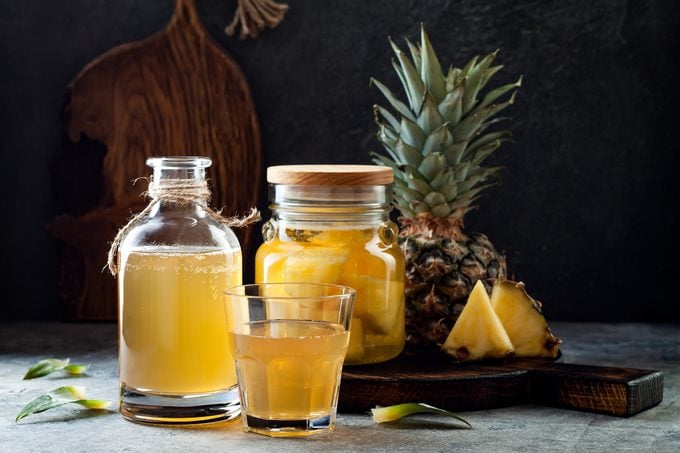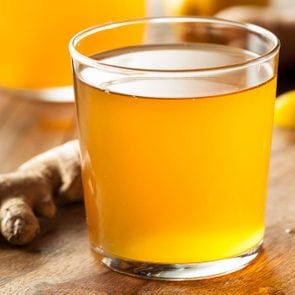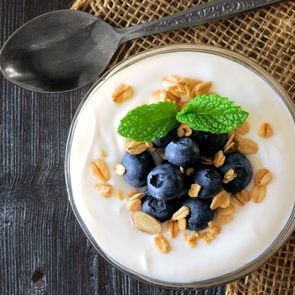Love Kombucha? Here’s Why You Need to Try Tepache
Updated: Jun. 15, 2021
Made from pineapple scraps, tepache is a refreshing drink richer in nutrients than its fermented-tea cousin kombucha. Plus, our registered dietitian nutritionist shares her own tepache recipe to make at home.
What is tepache?
When Su-Nui Escobar, RDN, was a child in Juarez, Mexico, she and her family would visit her aunt in Veracruz. After the long journey, she looked forward to a “healthy treat.” Specifically: a refreshing, bubbly drink of tepache.
To make it, her aunt filled a glass jar with the skin and core of a pineapple, water, piloncillo (a raw cane sugar with a molasses-like flavor often used in Mexican cooking), and a cinnamon stick. She covered the top of the jar with cheesecloth, to keep away fruit flies and allow the fermenting mixture to “breathe,” and then let it sit at room temperature for three days.
The result: a fizzy, lightly sweet beverage with a touch of alcohol (Escobar estimates about three percent). “It was such a big treat to have it,” she says.

A tasty drink made from discards
“In my house, when we ate pineapple, that stuff would go in the compost,” says Escobar. “In her house, that was something you saved and made something out of it. Now that we’re making food sustainable, I find it really cool that you can use the part that you normally discard from the fruit.”
Tepache can be made from the skin and cores of other types of fruit—like apples—too, she says. Trendy in Mexico City bars and restaurants, often mixed in craft cocktails, tepache is thought to have originated in the south of Mexico. Indigenous people from other parts of what’s now Latin America also developed fermented drinks; for example, chicha, made from fermented corn.
Tepache and nutrition
Because it’s made from fruit, tepache is rich in nutrients including manganese, vitamin C, phosphorous, and calcium. The Mexican drink contains bromaline and other enzymes that help with digestion, says Escobar. “Also you have some antioxidants, and of course antioxidants help with so many things.”
Fermentation and your microbiome
Fermented beverages like tepache, as well as fermented foods, help the community of friendly bacteria, fungi, and other microorganisms known as the microbiome to thrive, Escobar says.
“The fermentation process creates these microorganisms,” says Jeremy Partl, a certified sports nutritionist and health coach. “Specifically, it starts to develop strains of probiotics which are like the beneficial bacteria for our gastrointestinal system.”
Fermentation also produces prebiotics like lactoferrin that fuel the growth of good bacteria, he adds.
Tepache is an ancient food preservative
People have used fermentation to preserve food and drink for millennia, making cheese and yogurt from milk; kimchi and sauerkraut from cabbage; and, of course, wine from grapes and beer from grain.
Fermentation occurs when enzymes break down glucose and other molecules anaerobically—in the absence of oxygen—and produce ethyl alcohol, carbon dioxide (the source of the fizz in some fermented drinks), and other byproducts.
Fermented foods have been studied extensively in the lab, but few human trials have investigated their health effects, according to a review of studies published in 2019 in the journal Nutrients.
Nevertheless, at least one randomized controlled trial suggests that the fermented milk drink kefir improves lactose absorption and helps wipe out the ulcer-causing bacterium Helicobacter pylori.
Keep an eye on added sugar
While tepache is supposed to be sweet, keep an eye on how much added sugar you’re consuming, Escobar advises. “You can drink it every day—just be aware that it does have sugar, so you have to take that into consideration and balance that with your overall diet,” she says.
If you opt for pre-made tepache, “some brands may have more sugar than you want.”
Her aunt, now living in California, sometimes uses agave to sweeten her tepache, says Escobar.
To make tepache at home, follow Escobar’s family recipe.
Tepache
Ingredients:
2 liters of water
1 cone of piloncillo (8 ounces) or 1 cup brown sugar
1 pineapple (peels and core only)
1 cinnamon stick
Instructions:
Heat water in a large pot until it starts to boil. Take the pot from the stove and add piloncillo or brown sugar and allow to dissolve. Transfer to a glass jar large enough to accommodate all the ingredients.
Cut off the crown of the pineapple and discard. Wash the outside of the pineapple with water and peel; add peels to jar.
Cut up the peeled pineapple and reserve the core. Add the core to the water and piloncillo/sugar mixture. (Store or eat the fruit.)
Add the cinnamon stick and cover with a cheesecloth or kitchen towel. This will allow air into the drink. Let the mixture rest for two or three days. Serve over ice.
















